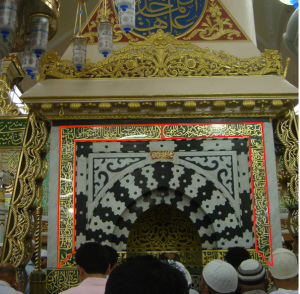Weeks 2 & 3: Visual and Auditory Experiences of Sacred Texts
Medium: Oral Recitation
As we have discussed throughout the semester, the aesthetic experiences of Islam are incredibly significant to spiritual practice and can be seen everywhere in the Muslim communities. This Spring Break, I happened to be traveling to the heart of Islam’s origins, Saudi Arabia. Spending time in both Makkah and Madinah, I got to experience the prevalence of Islamic expression all around me. From decals on cars to small signs and symbols in the windows of every shop, influences of Islam and its history in these cities was everywhere. In weeks 2 and 3, we learned about two different aesthetic aspects of God’s word: sacred design through calligraphy and sacred sound through oral recitation. For this piece, I decided to integrate the two. In the Masjid An-Nabawi in Madinah, which is also the resting place of the Prophet Muhammad (peace be upon him), calligraphy is seen all over the mosque. From lamps that have the shahada inscribed onto them to ornate ceiling designs that highlight verses from the Quran, the role of calligraphy is clear. Some of the most beautiful calligraphy I got to see in the mosque was surrounding the Prophet’s grave. There is also lots of calligraphy across the entire Mihrab. Because photography is not allowed in the mosque, and the mihrab is essentially inaccessible to women, I found a photo of the Mihrab to use for the purposes of this project. I decided to pair the calligraphy on the Mihrab with my own attempts at practicing oral recitation, recording recitations of the verses and prayers inscribed along the archway of the Mihrab.
Here is a photo of the Mihrab itself, with the archway circled in red:

Because of my Muslim background and my experience as a student of the Arabic language, I was able to read with Tartil without significant difficulty. However, engaging with Tajwid was much trickier for me. I read through this site to learn some of the rules of tajwid to use while reciting and listened to a few different recitations of the verses on the archway before attempting my own recitation.
The melding of visual and auditory experiences of the Quran allow for a holistic experience of faith. In fact, Muslims are able to experience this union at the mosque during each of the five prayers. While the recitation during the prayers does not necessarily mimic what is written on the surrounding walls, the atmosphere created by the calligraphy and other forms of religious art undoubtedly contribute to the sacred experience of praying within the Masjid An-Nabawi.
Photo source:
https://holyhijaz.files.wordpress.com/2013/02/rightof-arch.png
You can leave a response, or